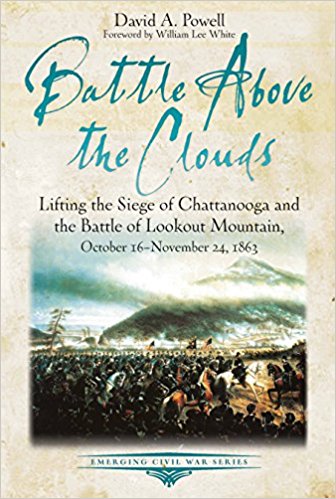Battle Above the Clouds: Lifting the Siege of Chattanooga and the Battle of Lookout Mountain, October 16 – November 24, 1863 by David A. Powell. Savas Beatie, 2017. Paper, ISBN 978-1-61121-377-5. $14.95.
 In his memoirs, Ulysses Grant famously described the Battle of Lookout Mountain as “all poetry.” In Battle above the Clouds, author David A. Powell, an authority on the Chickamauga and Chattanooga campaigns, goes beyond Grant’s dismissal to give the dramatic clash its due. Powell’s book, one of the latest in the Emerging Civil War series, covers not only the November 24, 1863 battle, but also the operations and skirmishes leading up to it. Battle above the Clouds is the first of a two-part study of the Chattanooga Campaign, to be followed by Powell’s All Hell Can’t Stop Them, which will chronicle the assaults on Missionary Ridge and the battle’s aftermath.
In his memoirs, Ulysses Grant famously described the Battle of Lookout Mountain as “all poetry.” In Battle above the Clouds, author David A. Powell, an authority on the Chickamauga and Chattanooga campaigns, goes beyond Grant’s dismissal to give the dramatic clash its due. Powell’s book, one of the latest in the Emerging Civil War series, covers not only the November 24, 1863 battle, but also the operations and skirmishes leading up to it. Battle above the Clouds is the first of a two-part study of the Chattanooga Campaign, to be followed by Powell’s All Hell Can’t Stop Them, which will chronicle the assaults on Missionary Ridge and the battle’s aftermath.
The narrative begins with Grant assuming command of the Military Division of the Mississippi, relieving William S. Rosecrans of command of the Army of the Cumberland, and travelling to the embattled city of Chattanooga. Here, Powell skillfully interrogates historical sources and questions what we think we know about the campaign. He recounts the familiar tableau of Grant reaching George Thomas’s headquarters after a cold, rain-soaked ride, sitting in front of the fire dripping wet, with Thomas seemingly too detached to offer his superior any hospitality. Powell points out that we only two detailed sources for the incident. James Wilson, Grant’s topographic engineer, inferred that Thomas was purposefully snubbing his commander, whereas Horace Porter, who subsequently became of one Grant’s most loyal staffers, attributed the oversight to Thomas’s focus on military preparations, rather than any malice.
With Grant in charge and reinforcements on the way, Union forces began the work of prying apart the Confederate encirclement of Chattanooga. Powell walks readers through the skirmishes at Brown’s Ferry and Wauhatchie, as well as the opening of the “Cracker Line” to better supply the growing assembly of U.S. forces. He also discusses infighting among the Union and Confederate high commands, with Oliver Howard and Henry Slocum chafing under Joseph Hooker’s command and Braxton Bragg radically restructuring his army after his disgruntled commanders petitioned Jefferson Davis for his relief. Two chapters address the successful storming of Lookout Mountain by Hooker’s forces. As Powell observes, part of the battle’s legacy was that Union commanders and soldiers debated amongst one another which unit performed what feat in the storied clash.
Among the book’s highlights are several detailed appendices, included detailed driving tours for Brown’s Ferry, Wauhatchie, Lookout Mountain, and Joseph Wheeler’s raids against Union supply lines. Lookout Mountain proved a popular tourist destination for Union soldiers following the battle, and Powell offers a study of photographs of officers and enlisted men posing at iconic spots such as Hanging Rock and Umbrella Rock. Especially interesting is Powell’s discussion of artist James Walker’s 1864 and 1873 paintings The Battle of Lookout Mountain. The latter, a massive canvas commissioned by and prominently featuring Joseph Hooker, is on permanent display at the National Park Service visitor center atop the mountain. The most argument-driven portion is the essay “The Myth of the Cracker Line,” contributed by historian Frank Varney. Contrary to Grant’s impressions, he asserts that Rosecrans had in fact taken steps to improve the supply situation in Chattanooga before he was relieved of command, and that his army was hardly close to “starving.” Some Army of the Cumberland soldiers wrote of being able to supplement their rations by foraging, and Varney speculates that an account of soldiers gathering corn fallen from supply wagons could have been men seeking forage for their animals rather than trying to feed themselves. Powell’s volume is generously illustrated with period images, modern photographs, and top-notch maps.
David A. Powell has brought considerable knowledge and skill in exploring multiple facets of a critical Civil War campaign. Battle above the Clouds offers readers a solid introduction to the Chattanooga Campaign, the means to explore its battles sites, and fodder for further debate—all of which bodes well for Powell’s next volume and the Emerging Civil War series.
Jonathan M. Steplyk received his Ph.D. in History at Texas Christian University and is the author of the brand new Fighting Means Killing: Civil War Soldiers and the Nature of Combat.




